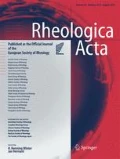Abstract
When the shear stress measured in large amplitude oscillatory shear (LAOS) deformation is represented as a 2-D Lissajous–Bowditch curve, the corresponding trajectory can appear to self-intersect and form secondary loops. This self-intersection is a general consequence of a strongly nonlinear material response to the imposed oscillatory forcing and can be observed for various material systems and constitutive models. We derive the mathematical criteria for the formation of secondary loops, quantify the location of the apparent intersection, and furthermore suggest a qualitative physical understanding for the associated nonlinear material behavior. We show that when secondary loops appear in the viscous projection of the stress response (the 2-D plot of stress vs. strain rate), they are best interpreted by understanding the corresponding elastic response (the 2-D projection of stress vs. strain). The analysis shows clearly that sufficiently strong elastic nonlinearity is required to observe secondary loops on the conjugate viscous projection. Such a strong elastic nonlinearity physically corresponds to a nonlinear viscoelastic shear stress overshoot in which existing stress is unloaded more quickly than new deformation is accumulated. This general understanding of secondary loops in LAOS flows can be applied to various molecular configurations and microstructures such as polymer solutions, polymer melts, soft glassy materials, and other structured fluids.



Notes
e3/e1< −1 corresponds to negative total stress at maximum positive strain γ = γ0, i.e., the material does not resist deformation but rather pushes towards further deformation. We are unaware of any observation of this type of behavior.
References
Bird R, Armstrong R, Hassager O (1987) Dynamics of polymeric liquids: volume 1 fluid mechanics. New York: Wiley
Burhin HG, Bailly C, Keunings R, Rossion N, Leygue A, Pawlowski H (2008) A study of polymer architecture with FT-rheology and large amplitude oscillatory shear (LAOS). In: XV international congress on Rheology: The Society of Rheology 80th annual meeting, Monterey (California), The Society of Rheology, abstract booklet, EM18
Cho KS, Ahn KH, Lee SJ (2005) A geometrical interpretation of large amplitude oscillatory shear response. J Rheol 49(3):747–758
Ewoldt RH, Hosoi AE, McKinley GH (2008) New measures for characterizing nonlinear viscoelasticity in large amplitude oscillatory shear. J Rheol 52(8):1427–1458
Ewoldt RH, Winter P, Maxey J, McKinley GH (2009) Large amplitude oscillatory shear of pseudoplastic and elastoviscoplastic materials. Rheol Acta. doi:10.1007/s00397-009-0403-7
Giacomin AJ, Dealy JM (1993) Large-amplitude oscillatory shear. In: Collyer AA (ed.) Techniques in rheological measurement, Ch 4. London: Elsevier
Jeyaseelan RS, Giacomin AJ (2008) Network theory for polymer solutions in large amplitude oscillatory shear. J Non-Newton Fluid Mech 148(1–3):24–32
Laeuger J, Heyer P, Stettin H (2009) Different experimental methods to characterize the non-linear behavior of gels. In: The Society of Rheology 81st annual meeting, Madison, WI, Paper VS5
Letwimolnun W, Vergnes B, Ausias G, Carreau PJ (2007) Stress overshoots of organoclay nanocomposites in transient shear flow. J Non-Newton Fluid Mech 141(2–3):167–179
Leygue A, Bailly C, Keunings R (2006) A tube-based constitutive equation for polydisperse entangled linear polymers. J Non-Newton Fluid Mech 136(1):1–16
Stadler FJ, Leygue A, Burhin H, Bailly C (2008) The potential of large amplitude oscillatory shear to gain an insight into the long-chain branching structure of polymers. In: The 235th ACS national meeting, polymer preprints ACS, vol 49. New Orleans, LA, USA, pp 121–122
Tee TT, Dealy JM (1975) Nonlinear viscoelasticity of polymer melts. Trans Soc Rheol 19(4):595–615
Wilhelm M (2002) Fourier-Transform rheology. Macromol Mater Eng 287(2):83–105
Author information
Authors and Affiliations
Corresponding author
Rights and permissions
About this article
Cite this article
Ewoldt, R.H., McKinley, G.H. On secondary loops in LAOS via self-intersection of Lissajous–Bowditch curves. Rheol Acta 49, 213–219 (2010). https://doi.org/10.1007/s00397-009-0408-2
Received:
Accepted:
Published:
Issue Date:
DOI: https://doi.org/10.1007/s00397-009-0408-2

